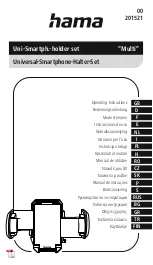
CABRIOLE’
CRAMARO TS S.r.l. – 37044 COLOGNA V.TA (VR) - VIA QUARI DESTRA, 71/G TEL. +39 0442/411688 / FAX + 39 0442/411690
E-MAIL [email protected] WEBSITE: http://www.cramaro.com -
Manual n° MCA016-EN-ED00 – date 15/01/15
page
14
FIG 1
Periodically check the tarpaulin's state of wear, especially in the most highly stressed
points like the front anchoring and the lateral fastening to the bows
Periodically check for the ends of all the bows and the state of
wear of the sliding runners that allow the
tarpaulin to move better
Periodically check the integrity of the sheet lifting PEHD strip inserted
on the sides of the sheet; should it be cut, the sheet would be damaged and tarpaulin
operation during retraction would be compromised (replace it).
Periodically check the cleanliness and proper operation of the electrical contacts
located between the frame and the container
Periodically make sure that the electrical connection cables are not damaged
Periodically wash the tarpaulin to remove any accumulated dirt, which can
damage it over time
Should the tarpaulin be used in particularly cold climates, it is absolutely
necessary to clean ice or snow off the canvas before using the tarpaulin, as these may
compromise the correct operation of the tarpaulin itself.
Periodically check the pulling rope CLAMP TIGHTNESS
DESCRIPTION OF THE TARPAULIN AND ITS POSSIBLE COMPONENTS AND VARIATIONS
The tarpaulin is essentially made up by:
1.
A manually, electrically or hydraulically activated mechanical unit that pulls the tarpaulin, to apply to the
front of the container.
2.
A certain number of metal bows that support the tarpaulin sheet.
3.
Two metal ropes that support, guide and make the bows slide along the upper edges of the container on
which the tarpaulin is assembled.
4.
A pulling rope return unit made up by two pulleys equipped with specific support to apply to the rear of
the container.
5.
A P.V.C. sheet with dimensions suitable to the dimensions of the container to cover, which also covers
the rear part of the container.
6.
A certain number of anchoring hooks (that differ based on user preference and the type of tarpaulin
selected) that allow the tarpaulin to be securely connected to the container on which it is assembled.
DIAGRAM OF FULLY EXTENDED TARPAULIN: CLOSED
(
CONTAINER COVERED
)















































